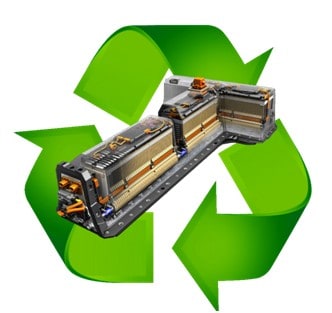
As electric vehicles are becoming more of a hot commodity, it is important to understand how their batteries are recycled.
The most common battery in standardized/internal combustion engine vehicles is a lead acid battery, which is typically used as the car’s starter batter. However, electric vehicles (e.g. hybrid, plug-in hybrid, or full battery EVs) are typically powered by lithium-ion batteries.
Li-Cycle Corp. is a closed loop lithium-ion battery recycler based in North America and with a global focus. CEO of Li-Cycle, Ajay Kochhar, said one of their company’s objectives is to act as a connector across the lithium-ion battery supply chain – from manufacturers to auto recyclers.
“The electric vehicle landscape and lithium-ion batteries are continuously developing,” Kochhar said.
He explained that in Canada, EV batteries can typically end up with one of two types of parties. If someone takes their car back into the dealership, then the dealer typically coordinates with the OEM to have the EV battery pack picked up and transported to a processing facility for suitable recycling. Kochhar said that this works “quite well and is continuing to develop further as EVs become much more common.”
The other type of party that it could end up with are groups outside the dealer, for instance, the collision repairers and auto recyclers. The possible challenge with this type of party is the current lack of specialized knowledge pertaining to high voltage lithium-ion batteries from EVs, including safe handling and transportation, Kochhar explained.
It’s a fact that everyone in the industry is used to the standardized (i.e. internal combustion engine) vehicles – the ones that have been on the road for over a century. But the big difference between the two is not only the type of batteries used but also the battery weight and power. EV batteries can weigh up to 500 kg and be up to 200 volts.
In order for the whole recycling supply chain to be the safest and most efficient, dealerships and the groups outside dealerships require training and increased awareness about the unique requirements for handling high voltage batteries.
Kochhar said that Li-Cycle actively collaborates with a broad range of stakeholders to meet this goal, so that the appropriate controls and training are in place in a number of years when many EV batteries require recycling.
Kochhar stressed the topic of safety. Many of the safety hazards are most prominent before EV batteries even reach recycling facilities – specifically, during transportation and handling (e.g. removal of high voltage batteries from EVs).
“Lithium-ion batteries are dangerous goods; when they are transported within Canada, requirements under Transport of Dangerous Goods Canada regulations must be abided by”.
Collaboration with OEMs to ensure that lithium-ion batteries are safely transported and handled across the supply chain is one of the suggestions he made. In order to improve the overall recycling rate of electric vehicle lithium-ion batteries, end-of- lifecycle value was emphasized as another focus area.
In the case of lead acid batteries, approximately 99 percent are recycled in North America, which is one of the highest recycling rates for any product. This high recycling rate has been driven by regulation and economics. Few lead acid batteries are lost through the supply chain, primarily due to the positive end-of-lifecycle value associated with the product.
One of the challenges to enabling value positive spent EV batteries is improving resource recovery/recycling technology. Right now, the way that most lithium-ion batteries are recycled is through traditional processing plants, typically involving a smelter (i.e. a high temperature process). Smelting typically only recovers 30 to40 percent of lithium-ion batteries and is often a relatively high cost process. This ultimately costs more money for the whole supply chain.
Mirroring the lead acid example, financial value/incentive would go a long way in promoting high recycling rates. This is a goal that Li-Cycle is focusing on through its closed loop recycling technology that can recover 80 to 100 percent of all lithium-ion batteries. Li-Cycle aims to transform the value of spent lithium-ion batteries over the next five to ten years. Of course, this will be driven by numerous factors, including the inherent residual value of spent lithium-ion batteries.
“When there is a higher end-of-lifecycle value there is often a higher recycling rate,” he said.
There are other uses for these batteries once they are deemed no good to power a vehicle. Kochhar mentioned that one of them is repurposing. An example of the repurposing would be Nissan’s “The Reborn Light” initiative in which they used lithium-ion batteries from EV’s to power Japan’s street lights.
Other end-of-lifecycle pathways include Repair, Refurbishing or Remanufacture.
